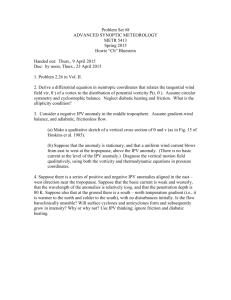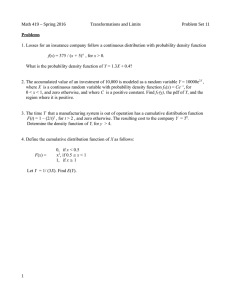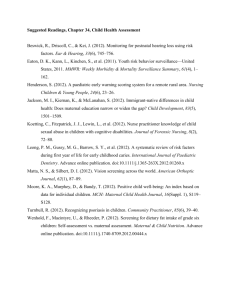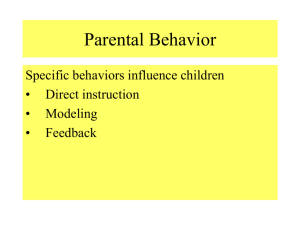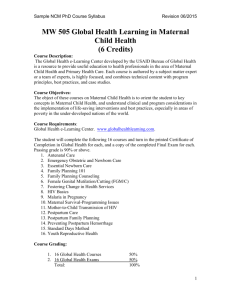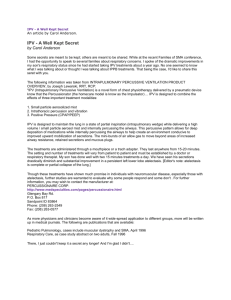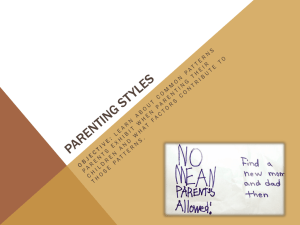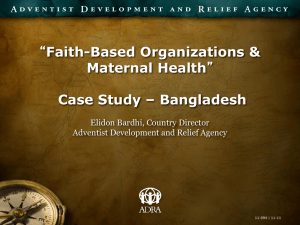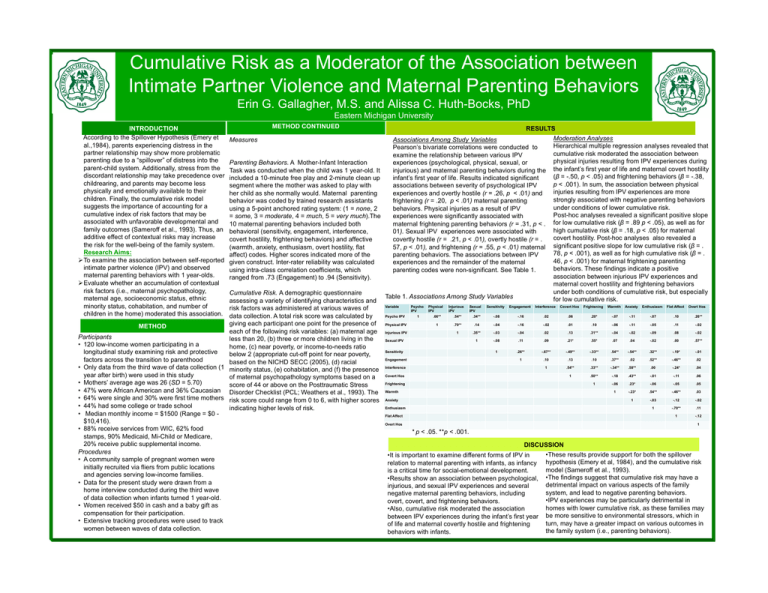
Cumulative Risk as a Moderator of the Association between
Intimate Partner Violence and Maternal Parenting Behaviors
Erin G. Gallagher, M.S. and Alissa C. Huth-Bocks, PhD
Eastern Michigan University
INTRODUCTION
According to the Spillover Hypothesis (Emery et
al.,1984), parents experiencing distress in the
partner relationship may show more problematic
parenting due to a “spillover” of distress into the
parent-child system. Additionally, stress from the
discordant relationship may take precedence over
childrearing, and parents may become less
physically and emotionally available to their
children. Finally, the cumulative risk model
suggests the importance of accounting for a
cumulative index of risk factors that may be
associated with unfavorable developmental and
family outcomes (Sameroff et al., 1993). Thus, an
additive effect of contextual risks may increase
the risk for the well-being of the family system.
Research Aims:
To examine the association between self-reported
intimate partner violence (IPV) and observed
maternal parenting behaviors with 1 year-olds.
Evaluate whether an accumulation of contextual
risk factors (i.e., maternal psychopathology,
maternal age, socioeconomic status, ethnic
minority status, cohabitation, and number of
children in the home) moderated this association.
METHOD CONTINUED
Measures
Parenting Behaviors. A Mother-Infant Interaction
Task was conducted when the child was 1 year-old. It
included a 10-minute free play and 2-minute clean up
segment where the mother was asked to play with
her child as she normally would. Maternal parenting
behavior was coded by trained research assistants
using a 5-point anchored rating system: (1 = none, 2
= some, 3 = moderate, 4 = much, 5 = very much).The
10 maternal parenting behaviors included both
behavioral (sensitivity, engagement, interference,
covert hostility, frightening behaviors) and affective
(warmth, anxiety, enthusiasm, overt hostility, flat
affect) codes. Higher scores indicated more of the
given construct. Inter-rater reliability was calculated
using intra-class correlation coefficients, which
ranged from .73 (Engagement) to .94 (Sensitivity).
RESULTS
Associations Among Study Variables
Pearson’s bivariate correlations were conducted to
examine the relationship between various IPV
experiences (psychological, physical, sexual, or
injurious) and maternal parenting behaviors during the
infant’s first year of life. Results indicated significant
associations between severity of psychological IPV
experiences and overtly hostile (r = .26, p < .01) and
frightening (r = .20, p < .01) maternal parenting
behaviors. Physical injuries as a result of IPV
experiences were significantly associated with
maternal frightening parenting behaviors (r = .31, p < .
01). Sexual IPV experiences were associated with
covertly hostile (r = .21, p < .01), overtly hostile (r = .
57, p < .01), and frightening (r = .55, p < .01) maternal
parenting behaviors. The associations between IPV
experiences and the remainder of the maternal
parenting codes were non-significant. See Table 1.
Moderation Analyses
Hierarchical multiple regression analyses revealed that
cumulative risk moderated the association between
physical injuries resulting from IPV experiences during
the infant’s first year of life and maternal covert hostility
(β = -.50, p < .05) and frightening behaviors (β = -.38,
p < .001). In sum, the association between physical
injuries resulting from IPV experiences are more
strongly associated with negative parenting behaviors
under conditions of lower cumulative risk.
Post-hoc analyses revealed a significant positive slope
for low cumulative risk (β = .89 p < .05), as well as for
high cumulative risk (β = .18, p < .05) for maternal
covert hostility. Post-hoc analyses also revealed a
significant positive slope for low cumulative risk (β = .
78, p < .001), as well as for high cumulative risk (β = .
46, p < .001) for maternal frightening parenting
behaviors. These findings indicate a positive
association between injurious IPV experiences and
maternal covert hostility and frightening behaviors
under both conditions of cumulative risk, but especially
for low cumulative risk.
Cumulative Risk. A demographic questionnaire
Table 1. Associations Among Study Variables
assessing a variety of identifying characteristics and
Variable
Psycho Physical
Injurious
Sexual
Sensitivity Engagement Interference Covert Hos Frightening Warmth Anxiety Enthusiasm Flat Affect Overt Hos
risk factors was administered at various waves of
IPV
IPV
IPV
IPV
Psycho IPV
1
.66**
.54**
.34**
-.08
-.16
.02
.06
.20*
-.07
-.11
-.07
.10
.26**
data collection. A total risk score was calculated by
giving each participant one point for the presence of Physical IPV
1
.70**
.14
-.04
-.16
-.02
.01
.10
-.06
-.11
-.05
.11
-.02
METHOD
each of the following risk variables: (a) maternal age Injurious IPV
1
.35**
-.03
-.04
.02
.13
.31**
-.04
-.02
-.09
.08
-.02
Participants
less than 20, (b) three or more children living in the
Sexual IPV
1
-.08
.11
.09
.21*
.55*
.07
.04
-.02
.00
.57**
• 120 low-income women participating in a
home, (c) near poverty, or income-to-needs ratio
Sensitivity
1
.26**
-.67**
-.49**
-.33**
.54**
-.54**
.32**
-.19*
-.01
longitudinal study examining risk and protective
below 2 (appropriate cut-off point for near poverty,
Engagement
1
.10
.13
.10
.37**
.02
.52**
-.46**
.02
factors across the transition to parenthood
based on the NICHD SECC (2005), (d) racial
1
.54**
.33**
-.34**
.58**
.00
-.24*
.04
• Only data from the third wave of data collection (1 minority status, (e) cohabitation, and (f) the presence Interference
Covert Hos
1
.50**
-.18
.43**
-.01
-.11
.06
year after birth) were used in this study
of maternal psychopathology symptoms based on a
• Mothers’ average age was 26 (SD = 5.70)
Frightening
1
-.06
.23*
-.06
-.05
.05
score of 44 or above on the Posttraumatic Stress
• 47% were African American and 36% Caucasian Disorder Checklist (PCL; Weathers et al., 1993). The Warmth
1
-.23*
.54**
-.46**
.03
• 64% were single and 30% were first time mothers risk score could range from 0 to 6, with higher scores Anxiety
1
-.03
-.12
-.02
• 44% had some college or trade school
Enthusiasm
1
-.70**
.11
indicating higher levels of risk.
• Median monthly income = $1500 (Range = $0 Flat Affect
1
-.12
$10,416).
Overt Hos
1
• 88% receive services from WIC, 62% food
* p < .05. **p < .001.
stamps, 90% Medicaid, Mi-Child or Medicare,
20% receive public supplemental income.
DISCUSSION
Procedures
• These results provide support for both the spillover
• It is important to examine different forms of IPV in
• A community sample of pregnant women were
relation to maternal parenting with infants, as infancy hypothesis (Emery et al, 1984), and the cumulative risk
initially recruited via fliers from public locations
model (Sameroff et al., 1993).
is a critical time for social-emotional development.
and agencies serving low-income families.
• Results show an association between psychological, • The findings suggest that cumulative risk may have a
• Data for the present study were drawn from a
detrimental impact on various aspects of the family
injurious, and sexual IPV experiences and several
home interview conducted during the third wave
system, and lead to negative parenting behaviors.
negative maternal parenting behaviors, including
of data collection when infants turned 1 year-old.
• IPV experiences may be particularly detrimental in
overt, covert, and frightening behaviors.
• Women received $50 in cash and a baby gift as
homes with lower cumulative risk, as these families may
• Also, cumulative risk moderated the association
compensation for their participation.
between IPV experiences during the infant’s first year be more sensitive to environmental stressors, which in
• Extensive tracking procedures were used to track
turn, may have a greater impact on various outcomes in
of life and maternal covertly hostile and frightening
women between waves of data collection.
the family system (i.e., parenting behaviors).
behaviors with infants.

